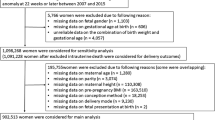Abstract
Objective
To determine delivery outcome in women undergoing induction of labor for postdate pregnancy in relation to fetal gender.
Study Design
A total of 365 nulliparous and 127 multiparous women carrying singleton postdate pregnancies with unfavorable cervix were enrolled. Clinical characteristics and delivery outcome were analyzed in relation to fetal gender.
Results
Women carrying male fetuses showed higher rate of caesarean section than those carrying females, in both nulliparous and multiparous women. Moreover, women carrying male fetuses presented more frequently with (i) interval between induction of labor and delivery >24 hours (P < .0002); (ii) augmentation of labor after cervical ripening (P < .0391); (iii) meconium-stained liquor (P< .0126); and (iv) higher neonatal weight (P < .0011) than those carrying females.
Conclusion
Male fetuses are more likely to be associated with higher rates of cesarean section. In maternal fetal medicine, gender differences may add prognostic information on the delivery outcome in women induced for postdate pregnancy.
Similar content being viewed by others
References
Kajantie E, Phillips DI. The effects of sex and hormonal status on the physiological response to acute psychosocial stress. Psychoneuroendocrinology. 2006;31(2):151–178.
Vatten LJ, Skjaerven R. Offspring sex and pregnancy outcome by length of gestation. Early Hum Dev. 2004;76(1):47–54.
Di Renzo GC, Rosati A, Sarti RD, Cruciani L, Cutuli AM. Does fetal sex affect pregnancy outcome? Gend Med. 2007;4(1):19–30.
Murphy VE, Gibson PG, Giles WB, et al. Maternal asthma is associated with reduced female fetal growth. Am J Respir Crit Care Med. 2003;168(11):1317–1323.
Murphy VE, Gibson P, Talbot PI, Clifton VL. Severe asthma exacerbations during pregnancy. Obstet Gynecol. 2005;106(5 pt 1):1046–1054.
Stark MJ, Dierkx L, Clifton VL, Wright IM. Alterations in the maternal peripheral microvascular response in pregnancies complicated by preeclampsia and the impact of fetal sex. J Soc Gynecol Investig. 2006;13(8):573–578.
Stark MJ, Clifton VL, Wright IM. Neonates born to mothers with preeclampsia exhibit sex-specific alterations in microvascular function. Pediatr Res. 2009;65(3):292–295.
Stark MJ, Clifton VL, Wright IM. Microvascular flow, clinical illness severity and cardiovascular function in the preterm infant. Arch Dis Child Fetal Neonatal Ed. 2008;93(4):F271–F274.
Stark MJ, Clifton VL, Wright IM. Sex-specific differences in peripheral microvascular blood flow in preterm infants. Pediatr Res 2008;63 4: 415–419.
Engel PJ, Smith R, Brinsmead MW, Bowe SJ, Clifton VL. Male sex and pre-exisiting diabetes are independent risk factors for stillbirth. Aust N Z J Obstet Gynaecol. 2008;48(4):375–383.
Eogan MA, Geary MP, O’Connell MP, Keane DP. Effect of fetal sex on labour and delivery: retrospective review. BMJ 2003;326(7381): 137.
Agarwal U, Anastasakis E, Kadir RA. The effect of fetal sex on the outcome of labour induction. J Obstet Gynaecol. 2009;29(8):711–713.
Gatward H, Simpson M, Woodhart L, Stainton MC. Women’s experiences of being induced for post-date pregnancy. Women Birth. 2010;23(1):3–9.
Schneider-Kolsky ME, D’Antona D, Evans L, et al. Maternal serum activin A and follistatin in pregnancy and parturition. BJOG. 2000;107(8):995–1000.
Wallace EM, Healy DL. Inhibins and activins: roles in clinical practice. Br J Obstet Gynaecol. 1996;103(10):945–956.
Reis FM, Gervasi MT, Florio P, et al. Prediction of successful induction of labor at term: role of clinical history, digital examination, ultrasound assessment of the cervix, and fetal fibronectin assay. Am J Obstet Gynecol. 2003;189(5):1361–1367.
Torricelli M, Novembri R, Voltolini C, et al. Biochemical and biophysical predictors of the response to the induction of labor in nulliparous postterm pregnancy. Am J Obstet Gynecol 2011;204(1): 39.
Reis FM, Fadalti M, Florio P, Petraglia F. Putative role of placental corticotropin-releasing factor in the mechanisms of human parturition. J Soc Gynecol Investig. 1999;6(3):109–119.
Challis JR, Smith SK. Fetal endocrine signals and preterm labor. Biol Neonate. 2001;79(3–4):163–167.
American College of Obstetricians and Gynecologists. Clinical management guidelines for obstetrician–gynaecologists. Technical Bulletin no. 107. Washington, DC: ACOG; 2009.
Wei SQ, Luo ZC, Qi HP, Xu H, Fraser WD. High-dose vs low-dose oxytocin for labor augmentation: a systematic review. Am J Obstet Gynecol. 2010;203(4):296–304.
Valensise H, Facchinetti F, Vasapollo B, Giannini F, Monte ID, Arduini D. The computerized fetal heart rate analysis in postterm pregnancy identifies patients at risk for fetal distress in labour. Eur J Obstet Gynecol Reprod Biol. 2006;125(2):185–192.
RCOG Clinical Effectiveness Support Unit. The use of electronic fetal monitoring: the use and interpretation of cardiotocography in intrapartum fetal surveillance. RCOG Evidence-Based Clinical Guideline, Vol 8. London, UK: RCOG Press; 2001.
Neal JL, Lowe NK, Ahijevych KL, Patrick TE, Cabbage LA, Corwin EJ. “Active labor” duration and dilation rates among low-risk, nulliparous women with spontaneous labor onset: a systematic review. J Midwifery Womens Health. 2010;55(4):308–318.
McEwen BS. Stress, sex, and neural adaptation to a changing environment: mechanisms of neuronal remodeling. Ann N Y Acad Sci. 2010;1204(suppl):E38–E59.
Craft RM, Mogil JS, Aloisi AM. Sex differences in pain and analgesia: the role of gonadal hormones. Eur J Pain. 2004;8(5):397–411.
Lieberman E, Lang JM, Cohen AP, Frigoletto FD Jr, Acker D, Rao R. The association of fetal sex with the rate of cesarean section. Am J Obstet Gynecol. 1997;176(3):667–671.
Clifton VL. Review: sex and the human placenta: mediating differential strategies of fetal growth and survival. Placenta. 2010; 31(suppl):S33–S39.
Sherer DM, Onyeije CI, Binder D, Bernstein PS, Divon MY. Uncomplicated baseline fetal tachycardia or bradycardia in postterm pregnancies and perinatal outcome. Am J Perinatol. 1998; 15(5):335–338.
Author information
Authors and Affiliations
Corresponding author
Rights and permissions
About this article
Cite this article
Torricelli, M., Voltolini, C., Vellucci, F.L. et al. Fetal Gender Effects on Induction of Labor in Postdate Pregnancies. Reprod. Sci. 20, 670–674 (2013). https://doi.org/10.1177/1933719112462631
Published:
Issue Date:
DOI: https://doi.org/10.1177/1933719112462631




